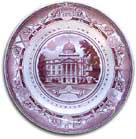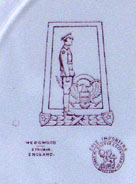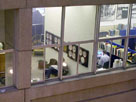| |
A&M plate collection finds permanent
home in college
 Student & faculty-designed antique china plates
depict historic university buildings
Student & faculty-designed antique china plates
depict historic university buildings
| |
|
A collection of Wedgwood plates depicting buildings on the Texas A&M campus and designed in the 1930s and 50s by Texas A&M architecture students and faculty have finally found their way home. The cherished China collection was donated to the College of Architecture by Jo Ann and Keith Langford, the son and daughter-in-law of the late Ernest Langford who served as head of A&M’s Department of Architecture from 1942 until 1966 and for whom A&M’s Langford Architecture Center is named.
The 15-plate collection, modestly appraised at $6,500, originally sold in a set of 12 for $24. Additional plates, depicting newer campus buildings, the All Faiths Chapel and the Memorial Student Center, were added to the collection in the 1950s.
“I just think that it is nice [for the college] to have something that belonged to the gentleman that the building is named after,” Keith Langford said after making the donation. “He [Ernest Langford] spent all his life at the College of Architecture. I just thought that is where they belonged.”
The Langfords contacted John O. Greer, the Wallie E. Scott Jr. Professor of Architecture Practice and Management and senior faculty member at the college, about donating the plates to the college. After compiling historical information on the plates, Greer shared the information with the Langfords and assured them that the college was interested in the donation.
“I think it is always important to maintain some touch with your history,” Greer said. “To have a link to that history is very special.”
The Langfords received the plates as a gift from the elder Langford in 1956, after moving into a new home in the Houston area.
The idea for commissioning the Texas A&M University plates from Wedgwood of England is attributed to Pinky L. Downs ’06, a member of the Board of Regents from 1923 to 1933. Downs, who is also credited with the invention of the Gig’em hand sign, actually sponsored the plate project.
The plates’ design was decided by competition between fourth- and fifth-year landscape arts and architecture majors staged in the spring of 1935. The winner, Jack F. Doyle ’35, earned $10 for his effort and was presented by Wedgwood with a complete set of the original 12 plates, which he still has.
“I was real proud to win,” said Doyle, a retired architect who currently resides in Georgia. “And ten dollars was a lot of money back then, especially when you were working for a quarter an hour.”
Professors Ernest Langford and F.W. Hensel further enhanced Doyle’s plate design before it was handed over to Wedgwood for production.
The additional plates, added in the 1950s, were designed by the late Richard E. Vrooman ’52, an A&M architecture professor who also designed the All Faiths Chapel, which is depicted on one of his plate designs. A 15th plate is included in the Langford collection to show the design on the back of all 14 plates — an Aggie cadet standing at attention.
The plates, one of three sets on the A&M campus, are on permanent display in the College of Architecture’s Technical Reference Center located in Building A of the Langford Architecture Center.
| |




 Click images to enlarge.
Click images to enlarge.
|
|
| |
|
|